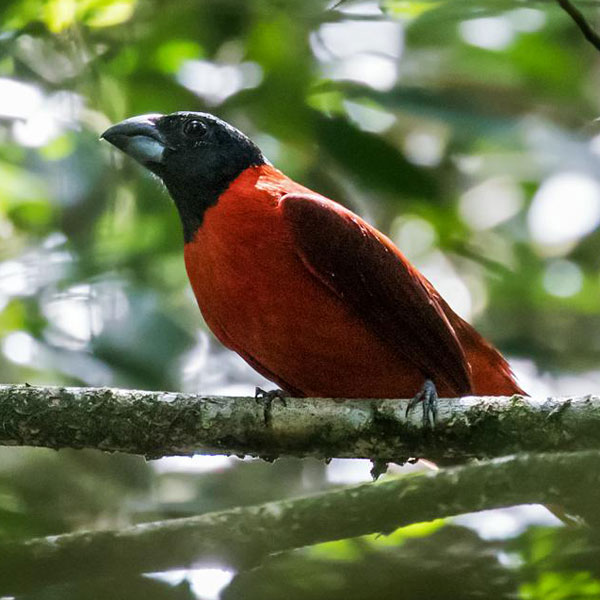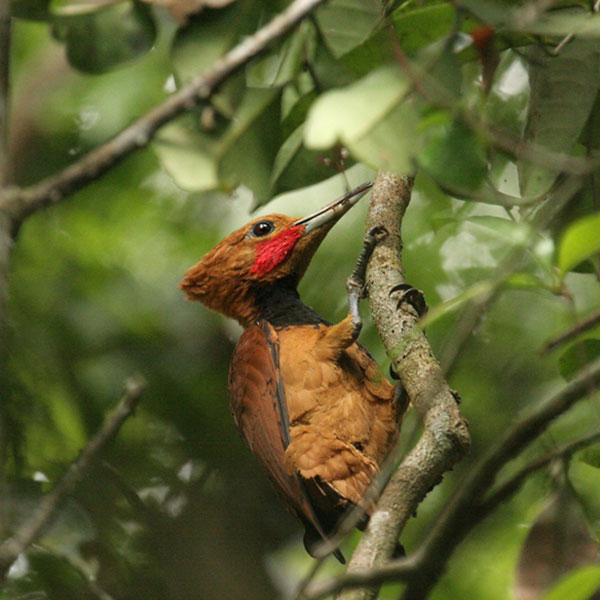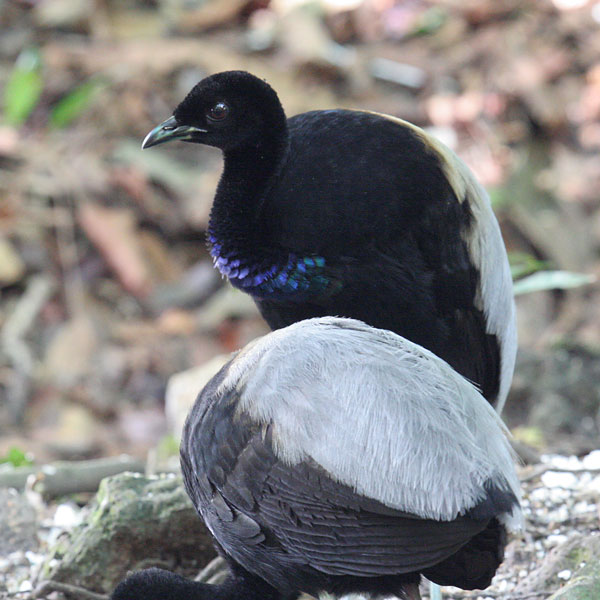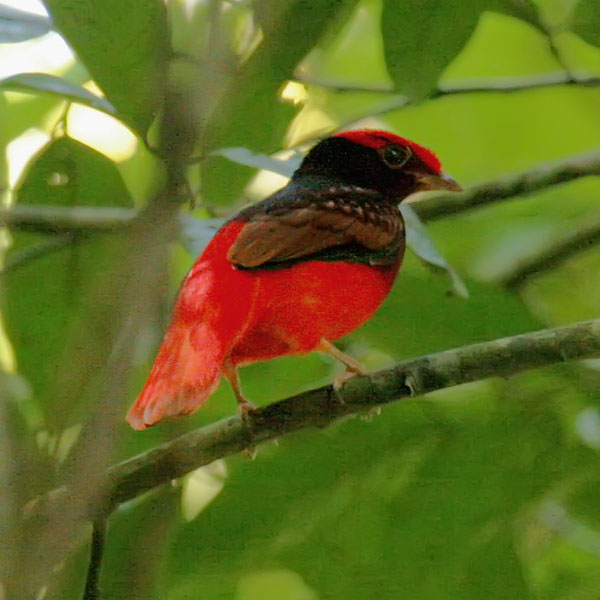BIRDWATCHING IN THE BROWNSBERG NATURE PARK & TONKA ISLAND
BROWNSBERG NATURE PARK
Accommodation & General Information
The Brownsberg can be reached by car after a two-and-a-half hour drive from Paramaribo. The last half hour we go slowly on the steep mountain road. It is recommended to come with a 4WD-car, although experienced drivers manage to get normal cars on the plateau. The STINASU (foundation for nature conservation in Suriname) has leased the park from the government and has built several lodges on the plateau, which have toilets and showers. Water supply is realized by a large system to catch rainwater and distribute it to the lodges. Water is also pumped from a source downhill into a large reservoir. During the great dry season it will be transported from the lake by tank cars. It is not recommended to drink this water. At night one can hear the frogs in the rainwater reservoirs under the lodges.
The lodge we usually use is called Kapasi (Armadillo). It is built on a cliff, a steep mountain side. The accommodation here is very basic and there are better lodges, but the view from the balcony into the canopy is marvelous and many good birds may be spotted from this balcony. There a two sleeping rooms, each has a double bed and a bunkbed (two single beds abouve each other) and a small kitchenroom with one bunkbed. Four participants can sleep in the two sleeping rooms, while the guide and the driver sleep in the kitchen room. We have a fridge and there is electricity. All meals are served in the small but good restaurant.
The Brownsberg is a large laterite plateau with an altitude of 450-500 meters, which used to be connected with other plateaus like the Nassau and Lely mountains. Rivers have eroded the land in between, and the three mountains are the remnants of the much larger laterite crust. The plateau and the slopes are covered with pristine rainforest, which is in some places very low and dense and in others high and open. Gold mining in the beginning of the 20th century has turned some creeks, coming from sources out of the mountain, into high waterfalls, which form a great attraction for many visitors. In several places, you will have marvelous views from the plateau over the rainforest on the slopes. The Mazaronitop offers views in three directions. It is near the lodges and can be reached after a ten-minute hike. Here we have a good chance of seeing canopy birds like Blood-red Tanager, Tropical Parula and Blue-backed Tanager.
The Brownsberg is a large laterite plateau with an altitude of 450-500 meters, which used to be connected with other plateaus like the Nassau and Lely mountains. Rivers have eroded the land in between, and the three mountains are the remnants of the much larger laterite crust. The plateau and the slopes are covered with pristine rainforest, which is in some places very low and dense and in others high and open. Gold mining in the beginning of the 20th century has turned some creeks, coming from sources out of the mountain, into high waterfalls, which form a great attraction for many visitors. In several places, you will have marvelous views from the plateau over the rainforest on the slopes. The Mazaronitop offers views in three directions. It is near the lodges and can be reached after a ten-minute hike. Here we have a good chance of seeing canopy birds like Blood-red Tanager, Tropical Parula and Blue-backed Tanager.
The Birds
The plateau is the best place for bird watching. We can walk on the broad roads near the lodges or take the Mazaroniweg. These roads offer a good view into the canopy. We will encounter many species of Antbirds. It is likely that we will hear the beautiful song of the Musician Wren, and there is a good chance of hearing forest falcons in the early morning. Interesting species which have been sighted quite regularly are Guianan Red Cotinga, Red-and-black Grosbeak, Ringed Woodpecker, Collared and Black-tailed Trogon and White-throated and White-fronted Manakins. The spectacular White Bellbird. which in the past could be heard from October till March has disappeared from the park. The rare and spectacular Band-tailed Antshrike has been seen often in the past, but has not been seen for many years now. Recently a lek of the Sharpbill has been found. We do not know yet the total period when the birds are active, but in February and March several can be heard singing. Seeing is possible, but difficult. The park is without doubt the best place to find Grey-winged Trumpeters. Every morning they are fed with rice and can be photographed from 5 meter. The near endemic White-throated Pewee, which was common on the plateau, had not been observed since 2009, has been found recently again along the mountain road to the plateau.
When the Pommerak and Walaba trees near the office flower, we can see more than 10 species of hummingbirds. When the Pommerak has ripe fruits, Guyanan Toucanets and Green Araçari’s will move five meters above your head. When the fruit of the Clusia near the Tapir viewpoint is ripe, honey-creepers, tanagers and woodpeckers can be spotted at very close range. When the bushes next to the Tapir-lodge has berries, we can see tanagers, 5 species of Euphonia’s and several species of Manakins. An Ornate Hawk-eagle has become tame and has been seen catching lizards on the ground next to people. He comes when the Ameiva-lizards have become abundant and leaves after eaten most of them.
A complete species list for the park can be found at the website of Jan Hein RIbot .
When the Pommerak and Walaba trees near the office flower, we can see more than 10 species of hummingbirds. When the Pommerak has ripe fruits, Guyanan Toucanets and Green Araçari’s will move five meters above your head. When the fruit of the Clusia near the Tapir viewpoint is ripe, honey-creepers, tanagers and woodpeckers can be spotted at very close range. When the bushes next to the Tapir-lodge has berries, we can see tanagers, 5 species of Euphonia’s and several species of Manakins. An Ornate Hawk-eagle has become tame and has been seen catching lizards on the ground next to people. He comes when the Ameiva-lizards have become abundant and leaves after eaten most of them.
A complete species list for the park can be found at the website of Jan Hein RIbot .
TONKA ISLAND
Tonka Island is situated on the east side of the foot of the Brownsberg in the hydro-electric Brokopondolake. Formerly it was the top of a hill. It can only be reached by boat. The boat trip starts at the lake site in Brownsweg and takes about half an hour. The island is covered with pristine rainforest, surrounded with a beach of laterite pebbles. White-eyed Parakeets breed in the dead tree tops surrounding the island. The Capuchinbird with its strange froglike song is very common.
Brownsberg Nature Park, Suriname
[photos ©] Ringed Woodpecker, Guianan Red Cotinga and Grey-winged Trumpeter, all taken by Candi McManiman. Red-and-Black Grosbeak by Nick Athanas.



